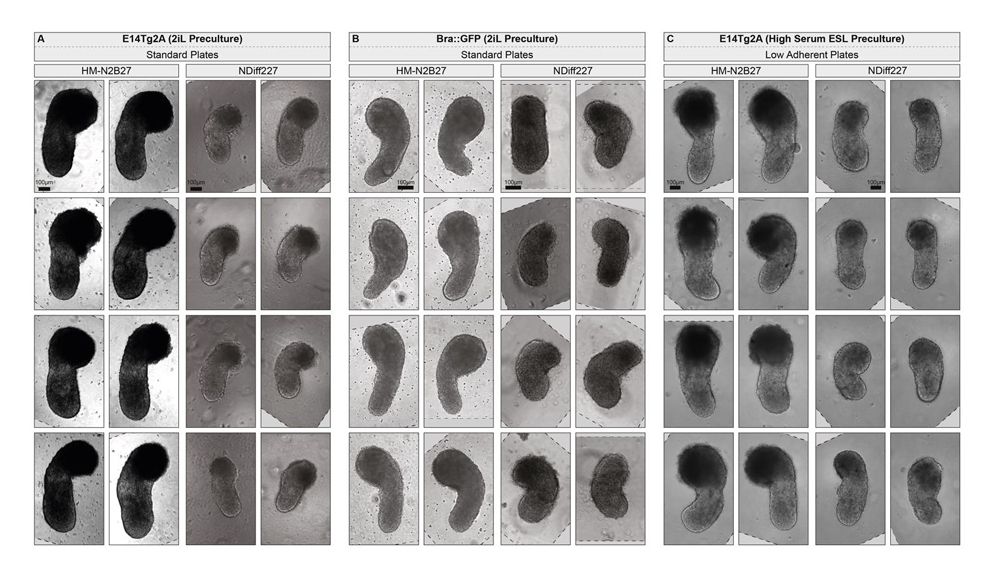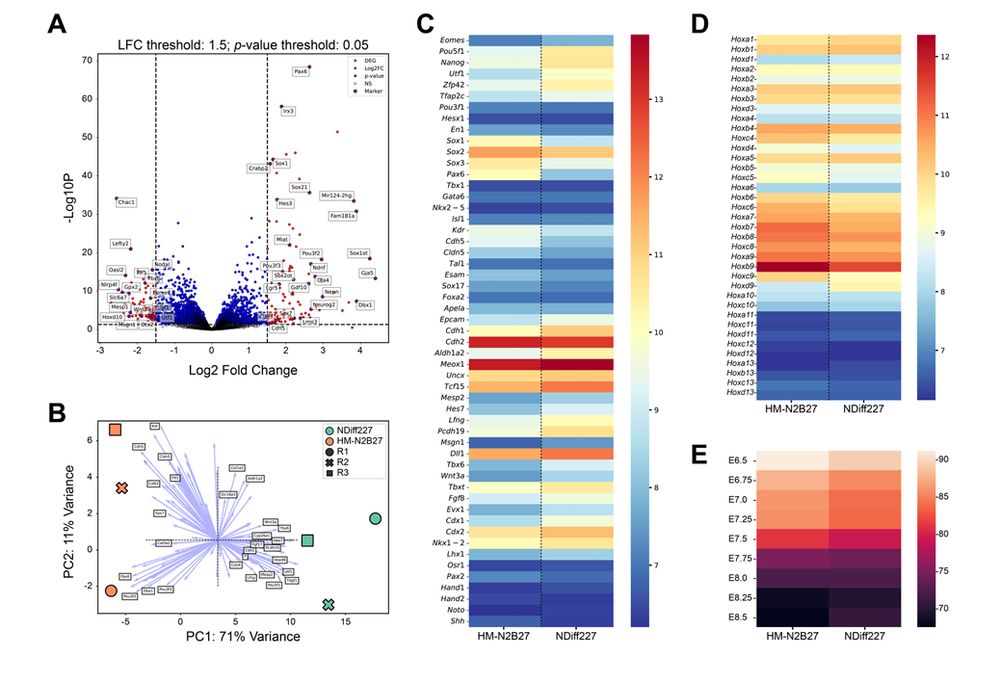
Causal modelling of gene effects from regulators to programs to traits - Nature
Approaches combining genetic association and Perturb-seq data that link genetic variants to functional programs to traits are described.
GWAS has been an incredible discovery tool for human genetics: it regularly identifies *causal* links from 1000s of SNPs to any given trait. But mechanistic interpretation is usually difficult.
Our latest work on causal models for this is out yesterday:
www.nature.com/articles/s41...
A short🧵:
11.12.2025 17:54 — 👍 108 🔁 57 💬 3 📌 1
Congrats!!
02.12.2025 11:25 — 👍 1 🔁 0 💬 0 📌 0

Specialized signaling centers direct cell fate and spatial organization in a mesodermal organoid model
Stem cell–derived mesodermal organoids reveal how signaling centers guide cell fate and tissue organization.
🎉 Our deconstructed, stem-cell–based approach to studying signaling centers and limb-development cell types is out! 🥳 So nice to see it in its final form after the preprint— and huge thanks to the community for all the enthusiasm and interest since then!
www.science.org/doi/10.1126/...
02.12.2025 09:14 — 👍 64 🔁 21 💬 5 📌 2

The new issue @cp-devcell.bsky.social brings the final form of our opossum heterochrony work www.cell.com/developmenta... And it also brings two great papers from @oliveringe.bsky.social @santoslab.bsky.social and @tobyandrews.bsky.social @rashmi-priya.bsky.social 🙌 great #DevBio from @crick.ac.uk
02.12.2025 11:06 — 👍 22 🔁 7 💬 4 📌 0
Several opportunities to join our group as a PhD candidate with bioinformatics or experimental background and interests in #microbiome, #Candida, or #evolution.
👉 IRB call:
www.irbbarcelona.org/en/careers/y...
👉 Inphinit call:
lacaixafoundation.org/en/doctoral-...
👉 EvoMG call
www.evomg-dn.eu
30.11.2025 11:35 — 👍 18 🔁 8 💬 0 📌 0

Join us next week for another round of inspiring VGZT talks! 🤩
🗓️ Thursday, December 4th
⏰ 9:30 PST / 12:30 EST / 17:30 UTC / 17:30 GMT / 18:30 CET
Our speakers are
👉 Luca Braccioli (@bracciolilab.bsky.social)
👉 Komal Makwana (on X: @Komal_Makwana4)
See you next week 👋
29.11.2025 10:07 — 👍 9 🔁 8 💬 0 📌 2
Your periodic reminder that science is not done by a few selected "stars scientists". Science is done by hundred of thousands. Siloed money mean a few flashy discoveries and a lot of waste. Want to change things? Make funding accessible and stop funding calls with less than 2% success rate.
29.11.2025 10:53 — 👍 208 🔁 74 💬 12 📌 5

📣 I hereby make my Bluesky debut to announce that our work linking DNA binding affinities and kinetics 𝘪𝘯 𝘷𝘪𝘵𝘳𝘰 and 𝘪𝘯 𝘷𝘪𝘷𝘰 for the human transcription factor KLF1 just got published in Cell! @cp-cell.bsky.social
www.cell.com/cell/fulltex...
Key findings in a thread (1/6):
27.11.2025 13:17 — 👍 98 🔁 33 💬 3 📌 2


There's increasing evidence that in organoid/embryoids conditions of cells at start of experiments is crucial/ determines outcome. Much to be learnt still. Taking advantage of mouse #gastruloids, two groups explore this here. Important work to calibrate the field www.biorxiv.org/content/10.1...
19.03.2025 12:01 — 👍 16 🔁 6 💬 1 📌 0

The missing heritability question is now (mostly) answered
Not with a bang but with a whimper
I wrote a little bit about the "missing heritability" question and several recent studies that have brought it to a close. A short 🧵
21.11.2025 22:33 — 👍 351 🔁 170 💬 14 📌 21

New IJDB issue! Our cover image features an immunostaining of neural crest cells and their derivatives in an Mllt1 E10.5 murine embryo from the paper by Zinck et al doi.org/10.1387/ijdb... Congratulations to the team of @aineurolab.bsky.social for their outstanding contribution!
19.11.2025 16:45 — 👍 4 🔁 6 💬 2 📌 0
Our new preprint is online! Viruses, bacteria and parasites use effector proteins to evade immunity and rewire host cell pathways. Together with @AlexanderStark8, we wondered if we could systematically map what these effectors, regardless of their origin, do in human cells. 1/8
18.11.2025 15:57 — 👍 49 🔁 21 💬 2 📌 1

New insights into islet ER stress responses, proinsulin biosynthesis, ERAD and ERD1 using β-cell-specific Hrd1-KO mice & rodent (and human islet) β-cells treated acutely with HRD1 inhibitor. jci.org/articles/vie...
@jci.org
18.11.2025 19:39 — 👍 14 🔁 4 💬 0 📌 1
🧵(1/12) November is Diabetes Awareness Month, and we have many works coming out from the CIRTN labs focusing on islet biology and diabetes. For the beginning of Nov 2025, we have papers from Drs Thompson, Verchere, Chen, Dhanvantari, Hill, Hoesli, Kin, Levings, Lynn, Riddell, Rutter and Wheeler.
17.11.2025 23:26 — 👍 12 🔁 7 💬 1 📌 0
TE x ZFP = Evolution!
Writing this with Olga @orpsf.bsky.social & Didier @trono-lab.bsky.social was a major highlight of my 🇨🇭sabbatical. Such a treat! 🍫Hope you enjoy it as much as we enjoy piecing it together.
18.11.2025 15:15 — 👍 50 🔁 18 💬 0 📌 0
Major new direction in the lab: hacking human cell biology with pathogen effectors (eORFs) - amazing collaboration with @miketilapia.bsky.social lab. Huge congrats to first authors Tomas & He & all co-authors! Check out the pre-print on @biorxivpreprint.bsky.social www.biorxiv.org/content/10.1...
18.11.2025 14:50 — 👍 54 🔁 24 💬 0 📌 2

It's always special when you find your own paper in the table of contents of the journal 😍
"The cis-regulatory logic integrating spatial and temporal patterning in the vertebrate neural tube" -> Now out in its final form
www.cell.com/developmenta...
18.11.2025 16:11 — 👍 85 🔁 20 💬 3 📌 1

Measuring mitochondrial membrane potential
@marcliesa.bsky.social , Guillermo Martínez-Corrales et al @ibmb-csic.bsky.social comment on common misinterpretation of mitochondrial membrane potential measurements & suggest guidelines for accurate determination in cells
www.embopress.org/doi/full/10....
17.11.2025 14:28 — 👍 20 🔁 11 💬 0 📌 2
Very happy with this comment out today! It was a fantastic teamwork effort, with invaluable input from the editor @embojournal.org and the reviewers. Thanks a lot to all involved! @csic.es @ibmb-csic.bsky.social
17.11.2025 15:23 — 👍 10 🔁 3 💬 0 📌 0

Spatially organized cellular communities shape functional tissue architecture in the pancreas
Spatial maps reveal dynamic epithelial-mesenchymal niches shaping pancreatic development and function.
🚨 Check out our new paper is now online in its final version!!!
🎉 👏 Congratulations @alejotorrescano.bsky.social who led the study
+ past & current team @labspagnoli.bsky.social
+ collaborators #VigilanteLab @kingslsm.bsky.social
➡️ doi.org/10.1126/scia...
short 🧵 below & more acknowledgments ⤵️
13.11.2025 15:56 — 👍 29 🔁 12 💬 1 📌 4
For scientists. By scientists. The official journal of the @isscr.org | Editor-in-Chief: Janet Rossant, CC, PhD
Cell and Developmental biologist, expanding into ecological thinking and evolutionary comparative approaches. Interested in how elevated temperatures affect embryo survival, focusing on pre-gastrulation development, in the context of global warming🌡
Stem cell and developmental biologist at the University of Liverpool
Menswear writer. Editor at Put This On. Words at The New York Times, The Washington Post, The Financial Times, Esquire, and Mr. Porter.
If you have a style question, search:
https://dieworkwear.com/ | https://putthison.com/start-here/
Associate professor at ETH Zurich, studying the cellular consequences of genetic variation. Affiliated with the Swiss Institute of Bioinformatics and a part of the LOOP Zurich.
We are the Canadian Islet Research and Training Network / Réseau de researche et formation sur les îlots du Canada.
Find out more at Islets.ca
Note: Account is primarily run by the volunteer trainee committee.
The Finnish Diabetic Nephropathy Study aims to identify the causes of diabetic complications, enabling their prevention and improving the quality of life for people with diabetes.
Eterno aprendiz. Arquímedes estaba equivocado, lo correcto es "Dame una cerveza y moveré el mundo" Me encanta jugar a la #PorraPool y perder
https://franvalverdes.blogspot.com/
https://www.youtube.com/@pacovalverde3592
Mentor, scientist & engineer. Having fun in @slavovlab.bsky.social and Parallel Squared Technology Institute @parallelsq.bsky.social with biology & single-cell proteomics.
https://nikolai.slavovlab.net
A scientific journal publishing cutting-edge advances at the intersection of the life and physical sciences. Posts by the editors.
Papá de Lautaro. Antropología climática en el CSIC. Surrealista extemporáneo y mc fracasado por vocación. Militancias varias por un mismo objetivo: descarbonizar el mundo y cambiar la vida. Entre ellas, en @institutomeridiano.org
VIB Center for AI & Computational Biology
🧑💻 Director @steinaerts.bsky.social
📣 We're recruiting group leaders vib.ai
📻 Follow us for all the latest updates
European Research Council, set up by the EU, funds top researchers of any nationality, helping them pursue great ideas at the frontiers of knowledge. #HorizonEU
Supporting children and young adults with Congenital Hyperinsulinism.
Family Support Group
Patient Led Research
Advocacy
Family Days and Conferences
https://linktr.ee/chcharityuk
Physicist trying to understand the behaviour of living organisms. Group leader at EMBL Barcelona.
Evolutionary biologist at Academia Sinica, Taiwan. We study the evolutionary genomics of marine invertebrates and use sequencing approaches to explore their biodiversity. More at: https://sgel.biodiv.tw/
Ubiquitin-like proteins and Development Lab @ CIC bioGUNE
Bilbao
Ubiquitin, SUMO, rare diseases, Drosophila, E3 ligases
https://www.rosabarriolab.es/
Opinions my own.
Molecular Neurobiology unit at Universitat de València. Studying neural stem cell biology and adult neurogenesis. Tweets by lab members. http://farinaslab.com
When I am not trying to understand embryos, I enjoy mountains, good music and gardening






















